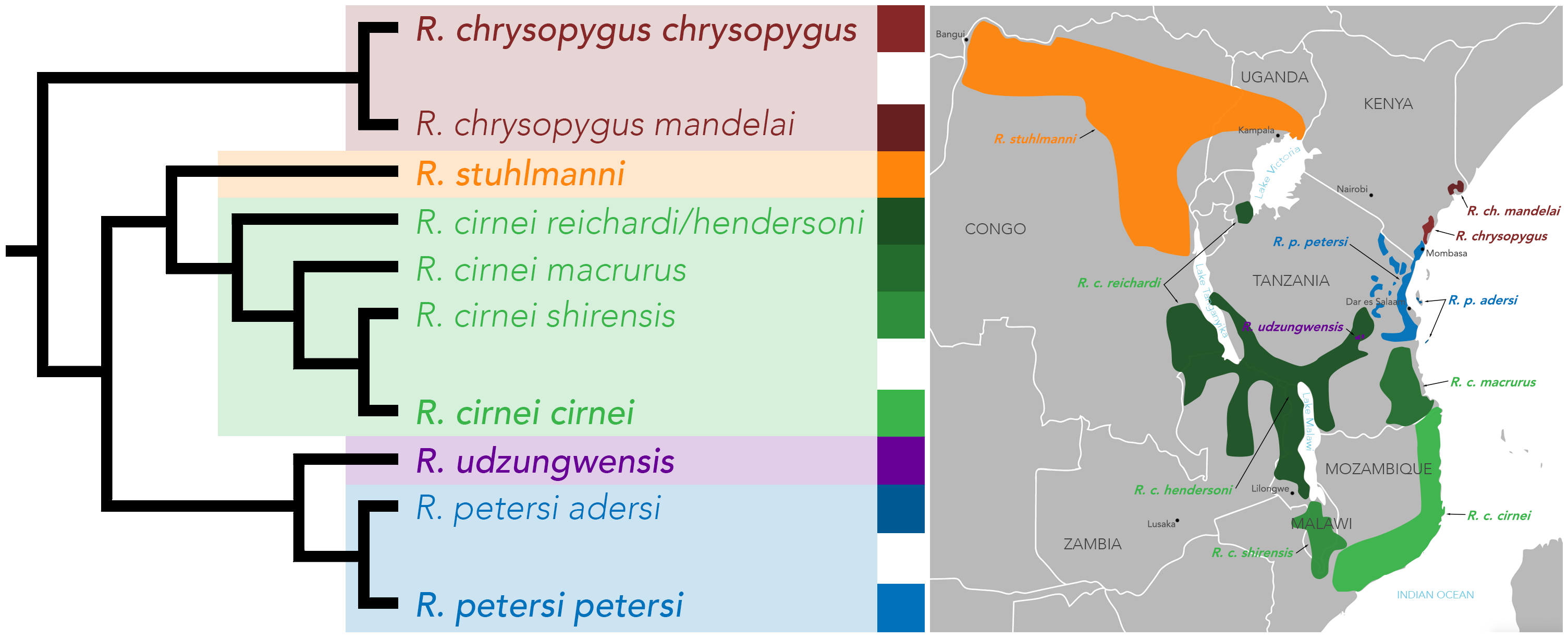Rhynchocyon chrysopygus-J Smit white background.jpg on:
[Wikipedia]
[Google]
[Amazon]
''Rhynchocyon'' is a genus of elephant shrew (or sengi) in the family Macroscelididae. Members of this genus are known colloquially as the checkered elephant shrews or giant sengis.
It contains the following five species:
*Golden-rumped elephant shrew, ''Rhynchocyon chrysopygus''
*Checkered elephant shrew, ''Rhynchocyon cirnei''
*Black and rufous elephant shrew, ''Rhynchocyon petersi''
*Stuhlmann's elephant shrew, ''Rhynchocyon stuhlmanni''
*Grey-faced sengi, ''Rhynchocyon udzungwensis''

Ecology
The giant sengis are endemic to Africa, and usually live in lowland Montane ecosystems, montane and dense forests, often "avoiding" edges of forest patches. They eat primarily insects such as beetles, termites, ants, and centipedes, using their proboscises to dig them from the soil and its tongue to lick them up. Their facial morphology limits their diets to tiny invertebrates, and unlike other members of Macroscelidea, do not supplement their diet with foods such as nuts or small fruits. They typically build ground level nests for shelter requiring dry leaf litter. The primary structure of a nest for ''R. udzungwensis'', for example, consists of the excavation of a cup-like indentation in the soil, layered with leaves, and the covered with looser leaves as a roof covering. They usually construct their nests at the base of trees. They also use hollowed, fallen trees or trunks to retreat in shelter. They are typically active in the day (Diurnality, diurnal), spending their nights sheltered. Other Macroscelidea species are known to bask in the sun as a method of thermoregulation to save energy. Giant sengis do not bask—and it is most likely due to their adaptation to shaded canopy forest environments. Sengis live in Monogamy, monogamous pairs, defending hectare-sized territories. Pairs spend little time together except when the female is in estrous. Mating occurs quickly and offspring grow quickly with minimal parental investment—none of which of is paternal. Each species exhibits distinct and varying coat patterns and colors. Species and subspecies found in denser forests exhibit darker coloration and patterns while open woodland species exhibit lighter, chequers. The darker species ''R. petersi'', ''R. chrysopygus'', and ''R. udzungwensis'' still contain vestigial chequers, but are masked by the blended dark fur between them. This makes coat patterns an unreliable indicator of species delineation. The species are described as follows: *''R. chrysopygus'' exhibits a bright yellow patch of fur on its rump with very little black coloration at all. ''R. chrysopygus'' has a unique dermal shield (a specialized thickening of skin) on its rump. *''R. petersi'' has mostly orange-rufous coloration on its feet, ears, tail, chest, and on its face. Black fur extends from its rump and thighs up to its shoulders. *''R. udzungwensis'' has black feet, ears and a tail. Its face is griseous grey with its lower rump and thighs are black. The chest is pale yellow. *''R. cirnei'' and its subspecies feature six dark-colored stripes and spots (chequers) on its back. They contain little to no black fur, are lighter in color, and differ markedly by their lack of orange-rufous coloration found on its coastal relatives ''R. petersi'', ''R. chrysopygus'', and ''R. udzungwensis''. The subspecies ''R. c. macrurus'' exhibits a Cline (biology), clinal variation different from coastal populations towards inland populations.Corbet, G.B., Hanks, J., 1968. A revision of the elephant-shrews, family Macroscelididae. Bull. Br. Museum (Natural Hist.) Zool. 16, 45–111. *''R. stuhlmanni'' exhibits a similar coloration and pattern as ''R. cirnei'' differing notably by its white tail.Taxonomy, distribution, and speciation
The genus' taxonomic status has been difficult to determine due to the very close similarities between populations. Up to ten species have been recognized, but over time they have been regrouped into four species. Recently, ''R. cirnei'', the species with the most subspecies, has had ''R. c. stuhlmanni'' separated into its own species based on updated molecular data. ''R. chrysopyguus'', ''R. cirnei'', and ''R. petersi'' are allopatric speciation, allopatrically distributed; with the more recently discovered ''R. udzungwensis'' and subspecies ''R. cirnei reichardi'' exhibiting parapatric speciation, parapatric distributions. Some introgression (hybrid (biology), hybridization) has taken place between ''R. udzungwensis'' and ''R. cirnei reichardi'' as detected by mtDNA. Estimated of population size and density vary and can be difficult to determine. However, measurements of the species populations has been undertaken. ''R. chrysopyguus'', in protected areas, is about 150 individuals per square kilometer (about 20,000 individuals); ''R. petersi'' is between 19–80 individuals per square kilometer; ''R. udzungwensis'' has an estimated 15,000–24,000 individuals. ''R. udzungwensis'' has a tiny distribution compared to the other species but resides in a protected forest.
References
External links Sengis.org
is an overview website concerning all the sengi species maintained by researcher Galen Rathbun, Galen B Rathbun of the university of the California Academy of Sciences. It hosts images, videos, bibliographies, among other topics about the order Macroscelididae.
{{Taxonbar, from=Q742434
Elephant shrews
Mammal genera
Taxa named by Wilhelm Peters
Taxonomy articles created by Polbot